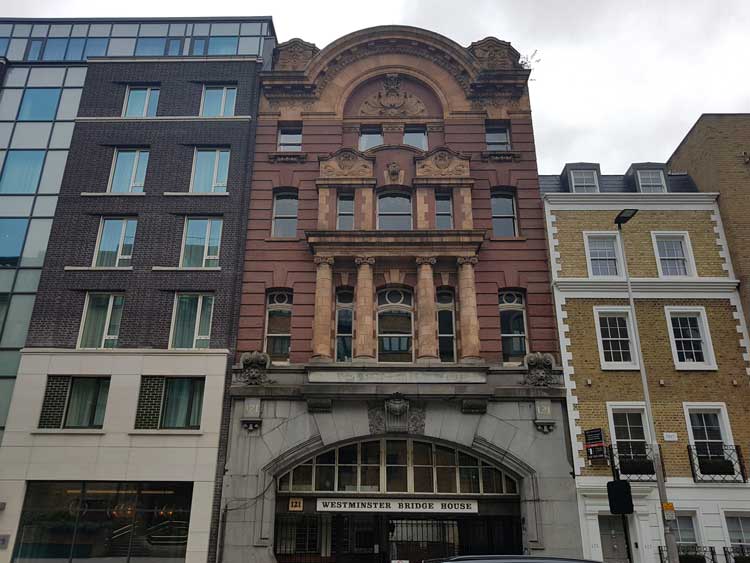
For 87 years, from 1854 until 1941, a bizarre train service - the London Necropolis Railway - ran an almost daily service from Waterloo Station to Brookwood Cemetery, carrying anything up to 2,000 bodies a year, and segregating both the living and the dead according to their class and their religious persuasion.
Closed down in the 1940's, the facade of the former offices of the company that ran the service can still be seen at number 121, Westminster Bridge Road, albeit there is nothing here to suggest that this was once the headquarters to an enterprise that, so its originators hoped, would make Brookwood Cemetery the only burial place that Londoners would consider being seen dead in for centuries to come.
But, what was the story behind what has been described as the "spookiest and strangest railway line in British history"?
Well, get yourself a cup of tea or coffee, pull up a chair, and I'll tell you.
In the first half of the 19th century, London's population shot up from around a million people in 1801 to close on two and a half million by 1851.
This, in turn, posed the problem of what to do with these citizens when they died.
The City's churchyards, the traditional final resting place of deceased Londoners, were unable to cope with the demand.
They were, quite literally, bursting at the seams, and, by the 1830's, the huge number of burials had raised the level of the churchyards, until, as Dickens would put it in Our Mutual Friend, they were "conveniently and healthfully elevated above the level of the living."
This, in turn, impacted on the health and well-being of the living, since the effluvium from the decaying corpses seeped into the City's water supply contaminating it and causing the deaths of thousands more Londoners, whose corpses, buried in the same overcrowded churchyards that had contributed to their deaths, started the whole insanitary ball game rolling again.
And so it went on, year after year after year etc.
Then, between 1846 and 1849, a devastating cholera epidemic swept across London, resulting in the deaths of 14,601 Londoners, and the capital's already struggling burial system was completely overwhelmed.
Something just had to be done
In 1851, Parliament, hoping to confront the problem head on, passed "An Act to Amend the Laws Concerning the Burial of the Dead in the Metropolis."
The new "Burials Act", as it was more succinctly known, tackled the problem by forbidding outright any new burials in the built-up areas at the centre of London.
Job done. Problem solved.
Except, people refused to play ball, and they just carried on dying in their thousands.
But, the powers that were had foreseen this eventuality, and private enterprise had been encouraged to step in and establish a series of huge cemeteries, in which Londoners could be laid to rest in lush, green spacious landscapes, each cemetery being established away from the overcrowded centre of London.
One such enterprise was the grandly titled "London Necropolis and National Mausoleum Company" (LNC), which was formed in July, 1852, with a mandate to develop the former Woking Common, at Brookwood, in Surrey, as one of the new cemeteries to serve London.
The promoters of the company had one overriding ambition, namely, to become London's one and only burial ground for ever more.
In order to achieve this lofty ideal, the promoters of the scheme knew that they would have to make their cemetery so attractive that Londoners wouldn't even consider burying their loved ones in any other cemetery..
Great efforts were, therefore, taken to ensure that, within the grounds of the cemetery, it would be perpetual spring; and the plants and trees used for the landscaping were selected with this in mind.
However, the promoters of the new cemetery had a major obstacle to overcome if they were to make theirs the only cemetery for the nation's capital. It was 23 miles outside London, and thus transporting the coffins of the deceased by the horse-drawn hearses of the age was going to take an eternity, not to mention be hugely expensive.
Unperturbed, the founders of the company, Sir Richard Broun and Richard Sprye, had come up with an ingenious solution to the problem of getting the dead from London to Brookwood Cemetery.
They would, they proposed, use the newly established railway system to transport the coffins and the accompanying mourners from London to Brookwood and (in the case of the mourners) back again.
But, as ingenious as it was, the plan to use the trains did not meet with universal approval.
Charles Blomfield, the Bishop of London, for example, opined that the noise and speed of the railways was incompatible with the solemnity of the Christian burial service.
He also argued that it would be unacceptable for the families of people from different social classes, both living and dead, to be forced to share the same train for the journey to the cemetery.
In addition to the awful prospect of the superior classes being forced to jostle with the riff-raff of London, there was also, so the saintly Bishop intoned, the decided possibility that the coffins of those who had led decent and wholesome lives might be stashed alongside the coffins of those whose lifestyles had been morally lax.
"It may sometimes happen", so the Bishop pointed out, "that persons of opposite characters might be carried in the same conveyance...For instance, the body of some profligate spendthrift might be placed in a conveyance with the body of some respectable member of the church, which would shock the feelings of his friends."
Amen to that!
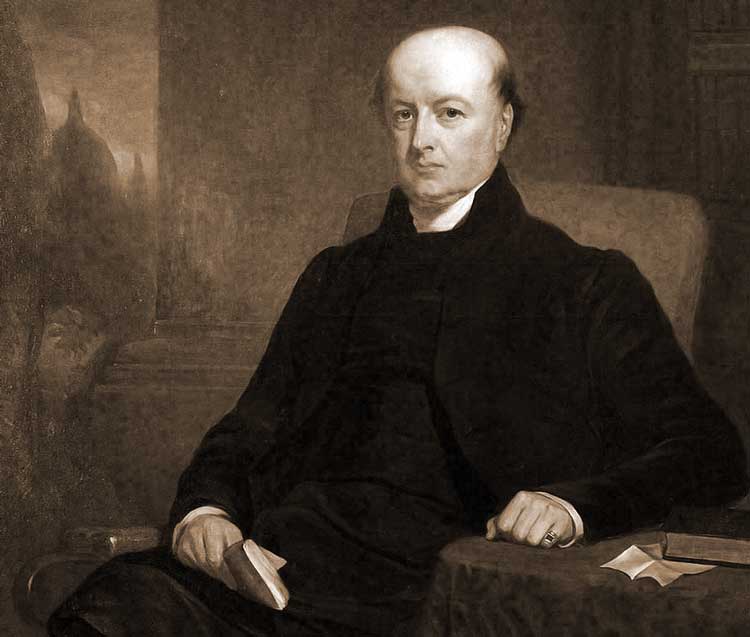
Charles Blomfield (1786 - 1857)
Bishop of London
There were also objections from the shareholders of the London and South Western Railway (LSWR), whose tracks and trains the proposed line to the cemetery would be using.
They were worried that the prospect of sharing their journeys with coffins and funeral parties might put passengers off using the company's trains, and that the resultant drop in numbers might reduce their trains to nothing more than a mere skeleton service (sorry, couldn't resist that one!).
Compromises were, therefore, proposed.
The class issue would be tackled by introducing three classes of passenger - first, second and third.
Each class would be carefully segregated from the others, both on the trains and in the stations, and the danger of the scented, superior classes coming face to face with, and being forced to breathe the same air as, the great unwashed would be kept to a bare minimum.
As for the concerns of the LSWR shareholders?
Well, they could be overcome by the simple ruse of establishing a special train service that would be dedicated solely to transporting people to and from Brookwood Cemetery.
But the next question was, where would this new Railway Station for the dead be situated?
Waterloo Bridge Station (as Waterloo was known until 1886) had been opened in 1848, and it was a site adjacent to this terminus that was chosen as the perfect location for for the new London Necropolis Railway Station.
The location had, so proponents of the scheme proposed, several advantages, one of them being that it was close enough to the River Thames for bodies to be transported to the station by River, a relatively inexpensive means of transport and a popular alternative at the time to London's busy, congested streets.
In addition, the proximity of three major bridges, Waterloo, Westminster and Blackfriars, also made it easily accessible for mourners who wishes to travel from north of the River by road.
Another important consideration was the fact that the arches of the huge brick viaduct, that carried the rails into and out of Waterloo Bridge Station, would make excellent mortuaries in which to store the dead before they commenced their journey to Brookwood.
The locals were not at all impressed when they heard that, potentially, a huge number of dead bodies would soon be taking up temporary residence close to their homes in preparation for their final journey, but their objections were largely ignored.
In June, 1854, The London Necropolis Company began building a single terminus building, on a plot of land between Westminster Bridge and York Street (now Leake Street), and, by October, 1854, the Cemetery Station was complete.
And thus, in November, 1854, one of Britain's most bizarre railway lines - the London Necropolis Railway - commenced operations, and daily trains were soon chuffing their way out of "Cemetery Station" in Waterloo, chugging their way through the outskirts of London, and on through verdant woodlands and lush, green countryside outside the Metropolis, bound for the tranquil oasis of the new Valhalla in rural Surrey.
In order to get the word out about this new enterprise, the company undertook a London wide publicity campaign, and several newspapers carried adverts announcing the opening of the cemetery and its connecting line.
The following example appeared in The Illustrated London News on Saturday,11th November, 1854:-
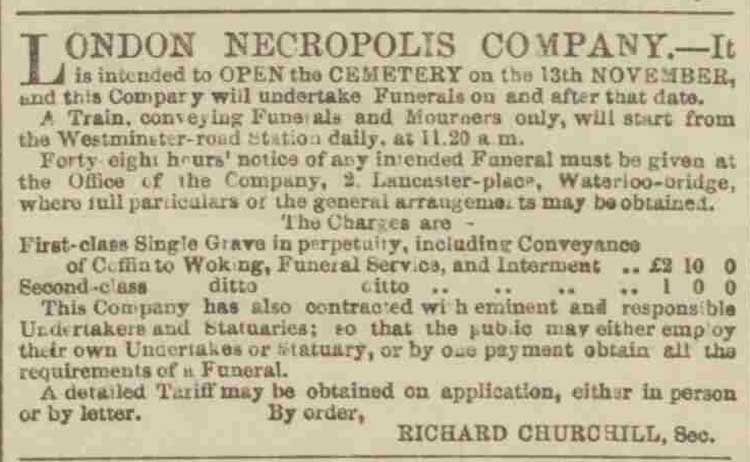
From The Illustrated London News. Saturday, 11th November, 1854
Copyright, Mary Evans Picture Library
The entrance to Cemetery Station was situated at number 188, Westminster Bridge Road.
Mourners entered through a pair of ornate iron gates that had originally been designed for the Great Exhibition of 1851.
Entering the ground floor, mourners would have found themselves in a grand entrance hall, from which a staircase ascended, up which those attending first and second class funerals could make their way to a series of private rooms. Those attending third class funerals had a separate, much smaller, entrance hall.
Much of the ground floor level was occupied by two mortuaries, where the bodies could be stored prior to the commencement of the journey.
On the first floor were located the waiting rooms for the the second and third class passengers, as well as the company's offices and the public toilets.
The actual railway shed was located on the second floor, and here were also situated the waiting rooms for the first class passengers.
There were two railway lines, one on each side of the single platform.
Steam-powered elevators raised the coffins from the ground floor to the second floor, although these elevators could also be operated manually should the need arise.
Should mourners be unwilling, or unable, to make the journey to Brookwood Cemetery, or the funeral service of the deceased could not be held in a London church for religious reasons, then one of the station's waiting rooms would be pressed into service as a funeral chapel.
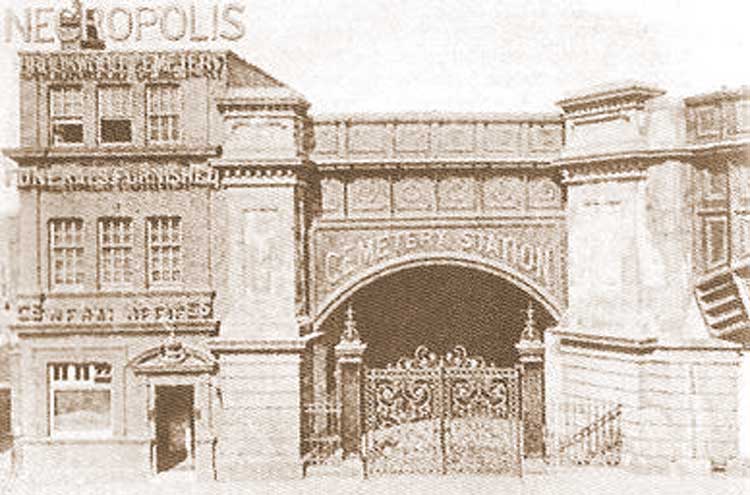
Cemetery Station, 188, Westminster Bridge Road
Headquarters of The London Necropolis Company
The first coffins to be loaded on to the train would be the first class ones.
Mourners would wait in one of the waiting rooms as the coffins were raised from the ground floor to the second floor.
Once this had been done, they were given the option of assembling on the platform to watch the coffin be slotted into place aboard the first class hearse carriage.
The names of the deceased would be announced once their coffins had been slotted into place, and the mourners for that particular person would then proceed to board the train.
In order to ensure that mourners travelled with the correct funeral party, the carriage doors would be labelled with the names of the deceased.
Next, the second class coffins and mourners would be boarded, and a similar procedure would be gone through.
Finally, the third class coffins would be placed on board, although their mourners were not allowed to witness them being loaded.
Third class mourners would be held in a special communal waiting room, shielded from the view of the first and second class passengers by an opaque glass screen, and then quickly ushered onto a communal carriage, once the first and second class passengers were on board and seated.
At 11.35am (11.20am on Sundays), the train would depart, and the mourners would be whisked through the lush green countryside - one of the reasons the route had been chosen was because of the attractiveness of the surrounding landscape through which the train would pass - to the wonderfully named "Necropolis Junction", arriving there at 12. 25pm.
The Illustrated London News was fulsome in its praise of the Necropolis Railway journey in the following article, which appeared on Saturday, 26th April, 1856:-
"We leave the dense city, and reach the open country with the speed of the winds.
We pass villages, and cottages, and farms, fields, and open tracts of country; we see in the distance woods and heathery uplands.
If it be summer, rivulet and little river and sedgy pool lie silvered in the sunlight, and wild flowers waft to us their scent from hedgerow banks, from fields, from blossoming heaths.
By-and-by the scene becomes wilder and more solitary.
The dun heath reaches us on either hand, and we seem, whether so or not, to toil up a rugged ascent, to break speed, make pauses; and then on, on our difficult way.
This sense of ascent adds inconceivably to the coming effect.
In an instant, the funeral train is unlinked from the giant power which led it on, and glides gently down into the undulating plain, which has thus been made one of the great burial-places of mighty London..."
The return trains to London generally left Brookwood at between 2.15 pm and 2.30 pm; the return journey taking around an hour around an hour.
Soon, all classes and all religious persuasions were making the journey from Waterloo to Brookwood, and business was booming.
Passenger numbers began to increase substantially and, by 1856, over 2,000 people a year were being laid to rest in Brookwood Cemetery, the vast majority of them making their final journey on the Necropolis Railway.
Refreshment rooms had been established at both ends of the line for the benefit of thirsty and hungry mourners, and these sold, among other things, alcoholic beverages, a bill of fare that attracted considerable criticism from the temperance movement, whose members felt it wholly inappropriate to encourage tippling amongst the mourners.
However, the claim that these rooms advertised "Spirits Served here", should, perhaps, be taken with a rather large pinch of salt!
The company was ever willing to exploit any positive feedback in its advertising campaigns, as can be seen from the following advert, which appeared in The West Surrey Times, on Saturday, 26th April, 1862:-
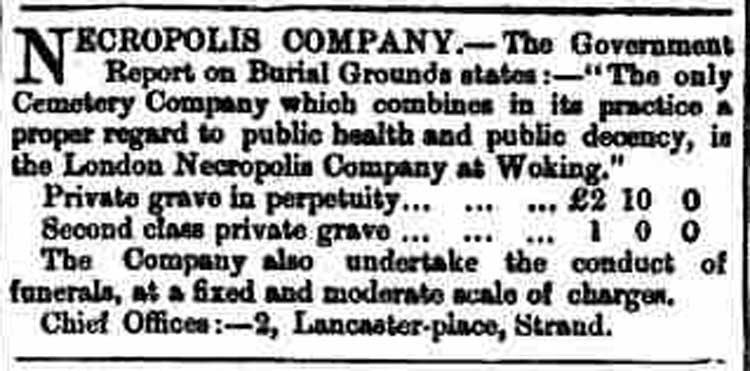
From The West Surrey Times. Saturday, 26th April, 1862
Copyright, The British Library Board.
Initially, the London Necropolis Company had used established undertakers to arrange and conduct funerals.
But, by the 1860's, it was realised that conducting all aspects of the funeral arrangements would be a far more profitable enterprise, and soon the company had branch offices all over London.
The service that was offered was on a par with the traditional undertaker, with the notable exception that the corpses were transported to the cemetery by train, as opposed to aboard the traditional horse-drawn hearse.
Another major difference was that of cost.
By keeping the whole shebang in-house, the company could undercut the prices charged by traditional undertakers and provide funerals that offered, so their publicity boasted, funerals "at a fixed and moderate scale of charge."
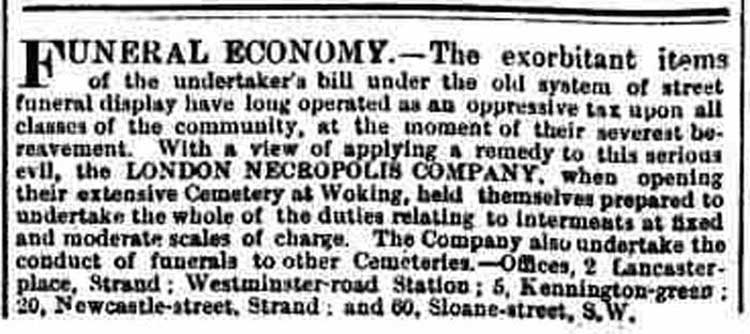
From The Globe. Monday, 25th February, 1867
Copyright, The British Library Board.
In the 1880's, the company even showed itself to be way ahead of the times.
By the late 19th century, it was beginning to be realised that traditional coffins, when buried in the earth, could leak all manner of pollutants and have a detrimental effect on the surrounding environment.
Consequently, there were numerous campaigns afoot to come up with less damaging methods of interring the dead.
Ever ready to capitalise on a business opportunity, the London Necropolis company patented the "Earth to Earth Coffin", and articles began appearing in the newspapers extolling the virtues of this latest innovation.
The Yorkshire Post and Leeds Intelligencer, heaped praise on the company's environmentally friendly approach in the following article, which was published on Tuesday, 2nd August, 1887:-
"The London Necropolis Company may be considered to have solved the question of the proper disposal of the dead by the adoption the "Earth to Earth" coffin, made of compressed pulp, sufficiently strong for all purposes above ground, but giving way rapidly coming into contact with the earth...It may be stated that, by the adoption of this form of coffin the London Necropolis Company, at their Woking Cemetery of 2,000 acres of land, will be able bury the dead of London for ever."
The funerals of popular Victorians might be extremely well attended, and extra trains would have to be laid on to carry the excessive numbers of mourners from Waterloo to Brookwood.
This was the case following the death, on 30th January, 1891, of Charles Bradlaugh (1833 - 1891) - the popular Liberal MP for Northampton, avowed atheist, founder of the London Secular Society, and a man who bore an uncanny resemblance to Marlon Brando in his twilight years - whose funeral was attended by 3,000 mourners, amongst them a 21-year-old Mohandas Gandhi.
The Shields Daily Gazette, reported on the cortege's slow journey to Brookwood, in its editions of Wednesday, 4th February, 1891:-
"The train being heavily freighted, the speed attained on the journey to Brookwood - a distance of about 23 miles - was never high.
Great interest was manifested in the train all along the line. From many windows white handkerchiefs were waved, bricklayers employed on roofless houses suspended their work to gaze upon the long line of carriages, and the agriculturists in the fields dropped their implements while they stared over the hedges at the passing train, which in due time pulled up at Brookwood station.
The remains of Mr Bradlaugh had, on the previous day been enclosed in what is known as an "earth to earth" coffin, the substance of which, being merely papier mache, is designed to decay almost immediately.
The coffin was then borne from deceased's residence at St. John's Wood to the premises of the Necropolis Company, where it was watched all night preparatory to being conveyed to Brookwood."
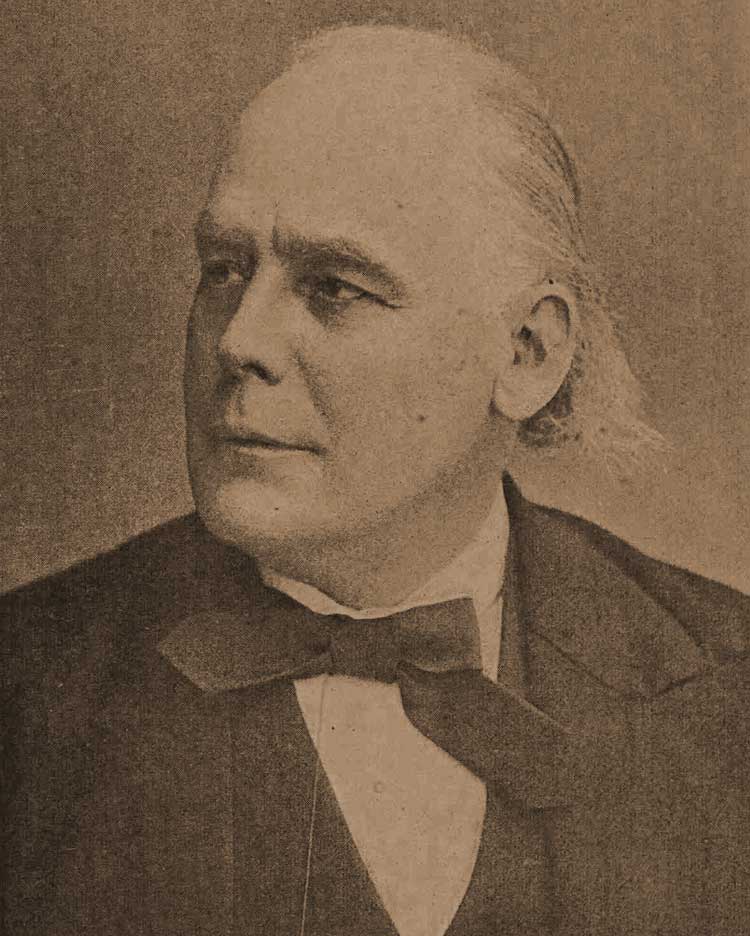
Charles Bradlaugh (1833 - 1891)
From The Illustrated London News, Saturday, 7th February, 1891.
Copyright, Mary Evans Picture Library.
By the 1890's, Waterloo Station was undergoing a huge expansion, and the Cemetery Station was in the way of a proposed enlargement of the viaduct out of Waterloo Station.
In 1896, the London and South Western Railway offered to build a new station for the London Necropolis Company in exchange for the site of their current station at 188, Westminster Bridge Road.
The London Necropolis Company, spotting an opportunity, agreed, on condition that they could have sole control over the design of the new terminus.
An agreement was struck, and, in 1899, work began on an ornate new building on the other side of Westminster Bridge Road, at number 121.
The new building was completed on the 8th of February, 1902, and the London Necropolis company decamped across the road to their new, more modern and ornate four-storey headquarters.
This is the building that still survives at number 121, Westminster Bridge Road, albeit there is nothing on the facade any more to even hint at its former usage.
However, following a recent clean-up, the building in which the company's offices were located has been restored to how it would have looked when it first opened in 1902.
On looking through the gates beneath the arch, passersby by can also still glimpse the tiled walls of the driveway that once led into the station.
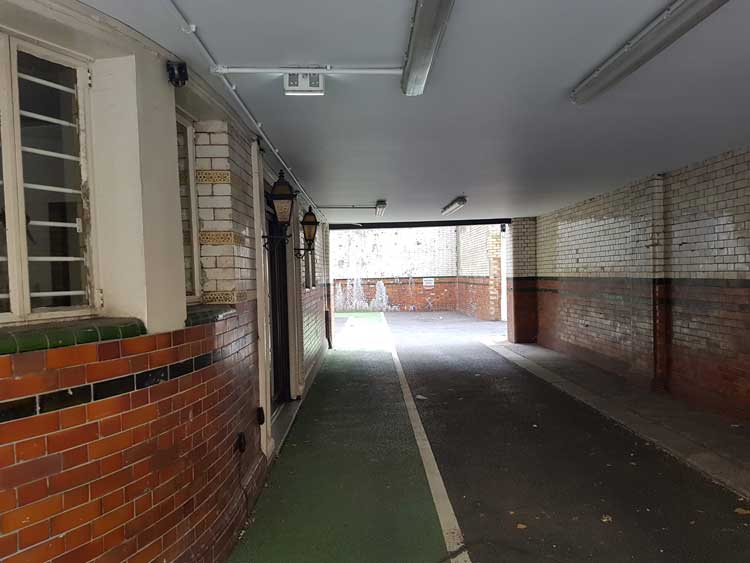
The Surviving Driveway - 2018
Unfortunately, competition from new municipal cemeteries, run by various London councils, combined with the advent of the motor car, which offered a convenient means of transporting bodies to the new cemeteries, led to a downturn in demand for the services of the London Necropolis Company and its railway.
Sunday services had been done away with in October, 1900, and, as the 20th century progressed, daily departures also began to be dropped, until, by the 1930's, the number of trains heading out to Brookwood had been reduced to just one or two trains a week.
On Friday, 11th April, 1941, the body of Chelsea Pensioner Edward Irish (1868 - 1941) left the London Necropolis Station en route for Brookwood.
Few who witnessed the departing cortege on that April day would have realised that they were watching the end of a remarkable chapter in London's bizarre history.
Five days later, on the night of the 16th/17th of April, 1941, a German bombing raid on the area destroyed the company's rolling stock, along with much of the building.
The Southern Railway's Divisional Engineer, having inspected the damage at 2pm, on April, 17th, 1941, reported starkly, "Necropolis and buildings demolished."
Although the offices and the first class entrance from Westminster Bridge Road had survived, the devastation effectively sounded the death knell for the Necropolis Railway, and, on the 11th of May 1941, the station was officially declared closed.
Following the end of the Second World War, it was decided not to resuscitate the station, and the site and surviving buildings were sold.
Nowadays, few people who pass the ornate building at number 121, Westminster Bridge Road take the time to pay it a second glance, and few of those who notice it realise that they are gazing upon a building that was once the operational hub of one of Britain's most unique and unusual railway lines.
R.I.P. The London Necropolis Railway.